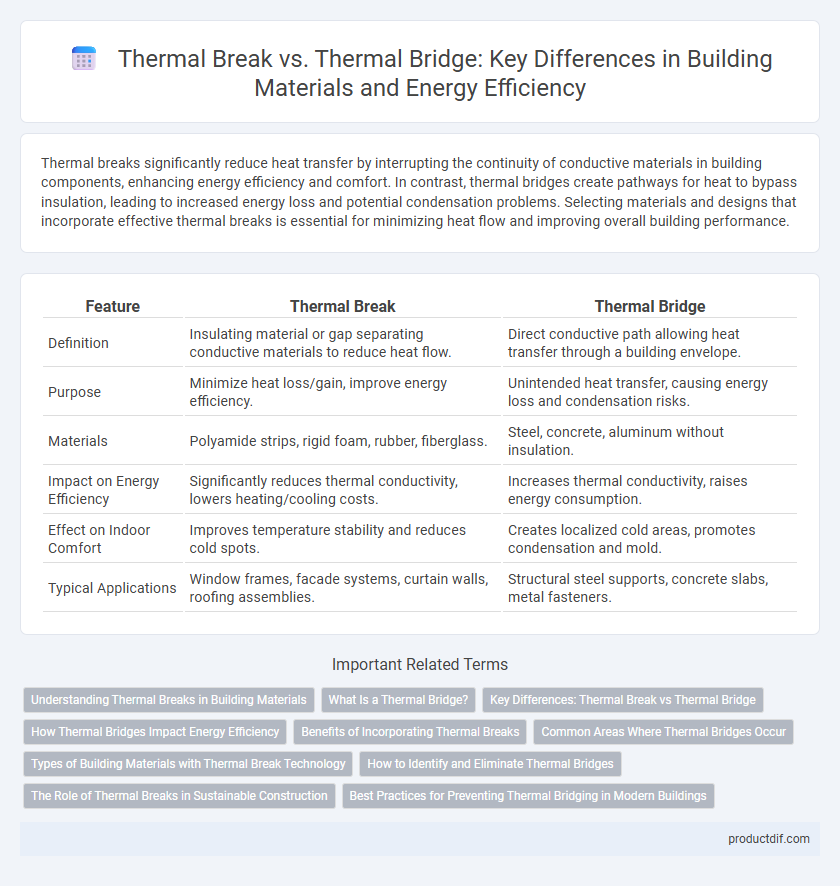Thermal breaks significantly reduce heat transfer by interrupting the continuity of conductive materials in building components, enhancing energy efficiency and comfort. In contrast, thermal bridges create pathways for heat to bypass insulation, leading to increased energy loss and potential condensation problems. Selecting materials and designs that incorporate effective thermal breaks is essential for minimizing heat flow and improving overall building performance.
Table of Comparison
| Feature | Thermal Break | Thermal Bridge |
|---|---|---|
| Definition | Insulating material or gap separating conductive materials to reduce heat flow. | Direct conductive path allowing heat transfer through a building envelope. |
| Purpose | Minimize heat loss/gain, improve energy efficiency. | Unintended heat transfer, causing energy loss and condensation risks. |
| Materials | Polyamide strips, rigid foam, rubber, fiberglass. | Steel, concrete, aluminum without insulation. |
| Impact on Energy Efficiency | Significantly reduces thermal conductivity, lowers heating/cooling costs. | Increases thermal conductivity, raises energy consumption. |
| Effect on Indoor Comfort | Improves temperature stability and reduces cold spots. | Creates localized cold areas, promotes condensation and mold. |
| Typical Applications | Window frames, facade systems, curtain walls, roofing assemblies. | Structural steel supports, concrete slabs, metal fasteners. |
Understanding Thermal Breaks in Building Materials
Thermal breaks are materials with low thermal conductivity inserted between conductive building components to reduce heat transfer, improving energy efficiency and indoor comfort. Unlike thermal bridges, which are pathways of high heat flow causing energy loss and condensation risks, thermal breaks disrupt this flow, minimizing thermal bridging effects. Effective use of thermal breaks in walls, roofs, and frames enhances insulation performance and contributes to sustainable building design.
What Is a Thermal Bridge?
A thermal bridge occurs when a material with high thermal conductivity creates a pathway for heat to bypass insulation in a building envelope, leading to heat loss or gain. Common in metal components such as steel framing or concrete beams, thermal bridges compromise energy efficiency and can cause condensation or mold growth. Addressing thermal bridges through insulated breaks or materials with low conductivity enhances overall building performance and reduces energy costs.
Key Differences: Thermal Break vs Thermal Bridge
Thermal break refers to materials or design techniques used to interrupt the path of heat flow in building envelopes, reducing thermal conductivity and energy loss. Thermal bridge is a physical component or area within a building structure where heat transfers more rapidly due to the presence of highly conductive materials like metal or concrete. The key difference lies in their function: thermal breaks act as intentional insulative barriers, while thermal bridges are unintended conduits of heat transfer that compromise energy efficiency.
How Thermal Bridges Impact Energy Efficiency
Thermal bridges significantly reduce a building's energy efficiency by allowing heat to bypass insulation through conductive materials, causing increased heat loss in winter and heat gain in summer. These localized weak points lead to higher energy consumption for heating and cooling systems, resulting in elevated utility costs and greater carbon emissions. Implementing thermal breaks interrupts these heat flow paths, enhancing overall thermal performance and reducing energy waste.
Benefits of Incorporating Thermal Breaks
Incorporating thermal breaks in building materials significantly reduces heat transfer, enhancing energy efficiency and lowering heating and cooling costs. Unlike thermal bridges that create pathways for heat loss, thermal breaks act as insulators within structural elements, preventing unwanted temperature fluctuations. This improves indoor comfort, minimizes condensation risks, and contributes to the overall sustainability of the building envelope.
Common Areas Where Thermal Bridges Occur
Thermal bridges commonly occur at junctions between walls, floors, and roofs, such as around window frames, balconies, and structural beams where insulation continuity is interrupted. These areas allow heat to bypass the thermal break, leading to increased energy loss and potential condensation issues. Effective design strategies include installing thermal breaks using insulating materials to minimize heat transfer and improve building envelope performance.
Types of Building Materials with Thermal Break Technology
Materials featuring thermal break technology include insulated metal panels, structural insulated panels (SIPs), and thermally broken aluminum frames, all designed to minimize heat transfer and improve energy efficiency in buildings. Polyurethane and polyisocyanurate foam cores provide superior insulation when integrated within metal framing, reducing thermal bridging significantly. These materials effectively interrupt the conductive path, enhancing building envelope performance and maintaining indoor comfort.
How to Identify and Eliminate Thermal Bridges
Thermal bridges occur when materials with high thermal conductivity create a path for heat flow, leading to energy loss and condensation issues, whereas thermal breaks are intentional insulating layers designed to interrupt this heat flow. To identify thermal bridges, use infrared thermography or heat flux sensors to detect temperature differentials on building surfaces. Eliminating thermal bridges involves incorporating continuous insulation, installing thermal break materials like foam or rubber strips between conductive elements, and designing window frames and structural components with thermal separation in mind.
The Role of Thermal Breaks in Sustainable Construction
Thermal breaks play a crucial role in sustainable construction by significantly reducing heat transfer between building interiors and exteriors, enhancing energy efficiency and occupant comfort. Unlike thermal bridges that create pathways for heat loss or gain, thermal breaks use insulating materials such as foam, rubber, or plastic to interrupt conductive heat flow in structural elements like window frames and exterior walls. Incorporating thermal breaks in building envelopes decreases HVAC loads, lowers carbon emissions, and supports green building certifications like LEED and BREEAM.
Best Practices for Preventing Thermal Bridging in Modern Buildings
Thermal breaks are materials or components with low thermal conductivity inserted between building elements to prevent thermal bridging, which occurs when heat transfers through conductive paths like metal frames or concrete slabs. Best practices for preventing thermal bridging in modern buildings include using continuous insulation, incorporating thermal break materials in framing systems, and designing with thermally resistant connectors. Proper detailing and installation of thermal breaks reduce energy loss, improve indoor comfort, and enhance overall building performance.
Thermal Break vs Thermal Bridge Infographic

 productdif.com
productdif.com